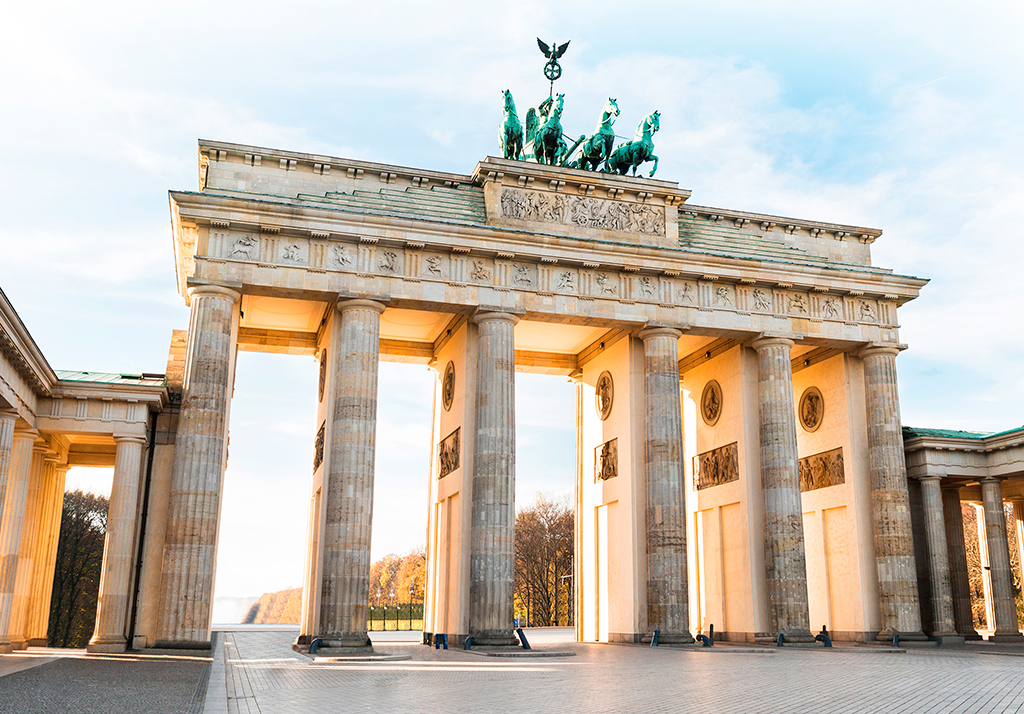The best known of Berlin’s symbols, the Brandenburg Gate stands proudly in the middle of Pariser Platz, asserting itself against the modern embassy buildings that now surround it. Crowned by its triumphant Quadriga sculpture, the famous gate has long been a focal point in Berlin’s history: rulers and statesmen, military parades and demonstrations – all have felt compelled to march through the Brandenburger Tor.
NEED TO KNOW
 Pariser Platz • Tourist information centre: Brandenburger Tor southern gatehouse • 030 25 00 25 • www.visitberlin.de • Open Apr–Oct: 9:30am–7pm daily; Nov–Mar: 9:30am–6pm daily
Pariser Platz • Tourist information centre: Brandenburger Tor southern gatehouse • 030 25 00 25 • www.visitberlin.de • Open Apr–Oct: 9:30am–7pm daily; Nov–Mar: 9:30am–6pm daily - One of the best spots for coffee in Pariser Platz is bistro Theodor Tucher.
- You can trace the course of the Wall along the former border patrol road, following the green-and-white Berliner Mauerweg signs. Historic interest and natural beauty alternate along the trail.
1.Brandenburger Tor
Built by Carl G Langhans in 1789–91 and modelled on the temple porticoes of ancient Athens, the Brandenburg Gate is the undisputed symbol of Berlin. Since the 19th century, this iconic landmark has been the backdrop for many events in the city’s turbulent history.

Brandenburger Tor
2.Quadriga
The 6-m (20-ft) high sculpture was created in 1794 as a symbol of peace by Johann Gottfried Schadow. As the model for the goddess of peace, he used his niece, who subsequently became famous throughout Berlin.

Quadriga
3.Hotel Adlon Berlin
Favoured by visiting dignitaries, the city’s most elegant hotel is a reconstruction. The legendary original, destroyed in World War II, hosted celebrities that included Greta Garbo, Thomas Mann and Charlie Chaplin.

Hotel Adlon Berlin
4.DZ Bank
This modern building, designed by the American architect Frank Owen Gehry, combines the clean lines of Prussian architecture with some daring elements inside (for further details see DZ Bank on Pariser Platz).
5.Akademie der Künste
Built in 2000–2005 and designed by Günter Behnisch and Manfred Sabatke, the Academy of Arts incorporates, behind a vast expanse of windows, the ruins of the old art academy, which was destroyed in World War II.
6.French Embassy
Christian de Portzamparc built this elegant building in 2001 on the site of the old embassy, which was ruined in World War II. Its colonnades and windows are a homage to the original.
7.Palais am Pariser Platz
This complex by Bernhard Winking is a successful modern interpretation of Neo-Classical architecture. Inside you will find a café, a restaurant and a souvenir shop around a pleasantly shaded courtyard.

Palais am Pariser Platz
8.Haus Liebermann
Josef P Kleihues built this in 1996–8, faithfully recreating the original that stood on the same site. The house is named after the artist Max Liebermann, who lived here. In 1933, watching Nazi SA troops march through the gate, he famously said: “I cannot possibly eat as much as I would like to puke.”
9.American Embassy
The last gap around Pariser Platz was finally closed in 2008. A dispute had delayed building for years: the US wanted a whole street moved for reasons of security, but had to concede the point in the end.

American Embassy
10.Eugen-Gutmann-Haus
With its clean lines, the Dresdner Bank, built in 1997 by gmp, recalls the style of the New Sobriety movement of the 1920s. In front of it is Pariser Platz’s famous original street sign.

Eugen-Gutmann-Haus



